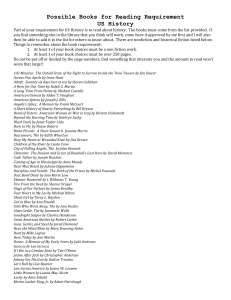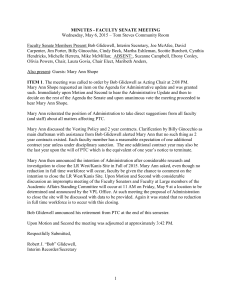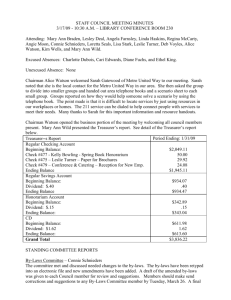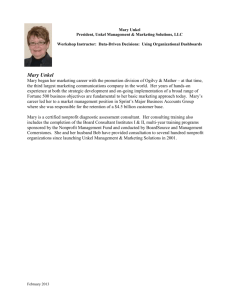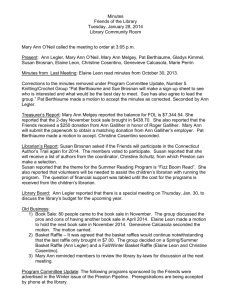3Whiting Wignall Families
advertisement
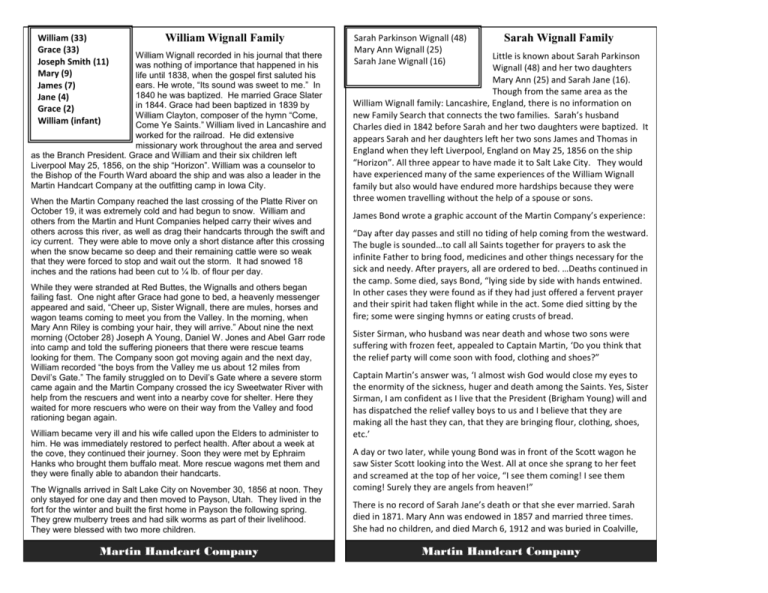
William (33) Grace (33) Joseph Smith (11) Mary (9) James (7) Jane (4) Grace (2) William (infant) William Wignall Family William Wignall recorded in his journal that there was nothing of importance that happened in his life until 1838, when the gospel first saluted his ears. He wrote, “Its sound was sweet to me.” In 1840 he was baptized. He married Grace Slater in 1844. Grace had been baptized in 1839 by William Clayton, composer of the hymn “Come, Come Ye Saints.” William lived in Lancashire and worked for the railroad. He did extensive missionary work throughout the area and served as the Branch President. Grace and William and their six children left Liverpool May 25, 1856, on the ship “Horizon”. William was a counselor to the Bishop of the Fourth Ward aboard the ship and was also a leader in the Martin Handcart Company at the outfitting camp in Iowa City. When the Martin Company reached the last crossing of the Platte River on October 19, it was extremely cold and had begun to snow. William and others from the Martin and Hunt Companies helped carry their wives and others across this river, as well as drag their handcarts through the swift and icy current. They were able to move only a short distance after this crossing when the snow became so deep and their remaining cattle were so weak that they were forced to stop and wait out the storm. It had snowed 18 inches and the rations had been cut to ¼ lb. of flour per day. While they were stranded at Red Buttes, the Wignalls and others began failing fast. One night after Grace had gone to bed, a heavenly messenger appeared and said, “Cheer up, Sister Wignall, there are mules, horses and wagon teams coming to meet you from the Valley. In the morning, when Mary Ann Riley is combing your hair, they will arrive.” About nine the next morning (October 28) Joseph A Young, Daniel W. Jones and Abel Garr rode into camp and told the suffering pioneers that there were rescue teams looking for them. The Company soon got moving again and the next day, William recorded “the boys from the Valley me us about 12 miles from Devil’s Gate.” The family struggled on to Devil’s Gate where a severe storm came again and the Martin Company crossed the icy Sweetwater River with help from the rescuers and went into a nearby cove for shelter. Here they waited for more rescuers who were on their way from the Valley and food rationing began again. William became very ill and his wife called upon the Elders to administer to him. He was immediately restored to perfect health. After about a week at the cove, they continued their journey. Soon they were met by Ephraim Hanks who brought them buffalo meat. More rescue wagons met them and they were finally able to abandon their handcarts. The Wignalls arrived in Salt Lake City on November 30, 1856 at noon. They only stayed for one day and then moved to Payson, Utah. They lived in the fort for the winter and built the first home in Payson the following spring. They grew mulberry trees and had silk worms as part of their livelihood. They were blessed with two more children. Martin Handcart Company Sarah Parkinson Wignall (48) Mary Ann Wignall (25) Sarah Jane Wignall (16) Sarah Wignall Family Little is known about Sarah Parkinson Wignall (48) and her two daughters Mary Ann (25) and Sarah Jane (16). Though from the same area as the William Wignall family: Lancashire, England, there is no information on new Family Search that connects the two families. Sarah’s husband Charles died in 1842 before Sarah and her two daughters were baptized. It appears Sarah and her daughters left her two sons James and Thomas in England when they left Liverpool, England on May 25, 1856 on the ship “Horizon”. All three appear to have made it to Salt Lake City. They would have experienced many of the same experiences of the William Wignall family but also would have endured more hardships because they were three women travelling without the help of a spouse or sons. James Bond wrote a graphic account of the Martin Company’s experience: “Day after day passes and still no tiding of help coming from the westward. The bugle is sounded…to call all Saints together for prayers to ask the infinite Father to bring food, medicines and other things necessary for the sick and needy. After prayers, all are ordered to bed. …Deaths continued in the camp. Some died, says Bond, “lying side by side with hands entwined. In other cases they were found as if they had just offered a fervent prayer and their spirit had taken flight while in the act. Some died sitting by the fire; some were singing hymns or eating crusts of bread. Sister Sirman, who husband was near death and whose two sons were suffering with frozen feet, appealed to Captain Martin, ‘Do you think that the relief party will come soon with food, clothing and shoes?” Captain Martin’s answer was, ‘I almost wish God would close my eyes to the enormity of the sickness, huger and death among the Saints. Yes, Sister Sirman, I am confident as I live that the President (Brigham Young) will and has dispatched the relief valley boys to us and I believe that they are making all the hast they can, that they are bringing flour, clothing, shoes, etc.’ A day or two later, while young Bond was in front of the Scott wagon he saw Sister Scott looking into the West. All at once she sprang to her feet and screamed at the top of her voice, “I see them coming! I see them coming! Surely they are angels from heaven!” There is no record of Sarah Jane’s death or that she ever married. Sarah died in 1871. Mary Ann was endowed in 1857 and married three times. She had no children, and died March 6, 1912 and was buried in Coalville, Utah. Martin Handcart Company Mary Ann Riley (40) Thomas Caton Riley (12) Riley Family (Traveled with William Wignall Family) Mary Ann (40) and Thomas (12) Riley both survived their trek to Zion. Mary Ann and her father were baptized on August 15, 1837 just two months after the first missionaries arrived in England. When her father died life became very difficult for Mary Ann and Thomas. The Saints were advised to go to Zion as soon as ways and means could be arranged. Mary Ann determined to take Thomas to Utah. While his mother was making preparations for the journey, Thomas was kidnapped and hidden by his father’s sister. He was however, returned in time to sail on the ship “Horizon.” They departed on May 25, 1856, with 856 English Saints on board under the direction of Edward Martin. Mary Ann’s husband remained in England. As Mary Ann had very little money, she joined the Martin Handcart Company. They began the 1,300 mile trek poorly outfitted. Their carts were made of green wood and required major overhauls along the way. Even though they reached Florence, Nebraska in less than four weeks, it was late August before they arrived at the Missouri River. October found them at the Platte River with early frost. There were bitter, cold winter storms. Food allotments were cut. Many were ill and exhaustion overcame them. The tents would freeze to the ground and many of the emigrants were forced to chew rawhide to reduce their hunger pains. Mary Ann had a friend to help her during this very hard time. It was Grace Wignall. Grace was traveling with her husband and six children including a newborn. Mary Ann and Thomas had evidently been helping their family, and they probably shared the same tent. After going to bed one night, Grace had a heavenly messenger appear to her. The messenger said, “Cheer up, Sister Wignall, there are mules, horses, and wagon teams coming to meet you from the Valley. In the morning, when Mary Ann Riley is combing your hair, they will arrive.” About nine the next morning (when Mary Ann was combing Grace’s hair,) Joseph A Young, Daniel W. Jones and Abel Garr rode into camp and told the suffering pioneers that there were rescue teams looking for them. Grace’s husband became very ill, and Grace called in the Elders to administer to him. He was immediately restored to full. When they finally reached the Salt Lake Valley, Mary Ann and Thomas were taken to Spanish Fork to the home of John Bates. Eventually Mary Ann was married and sealed to him, providing Thomas with a father. Martin Handcart Company

